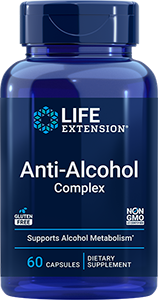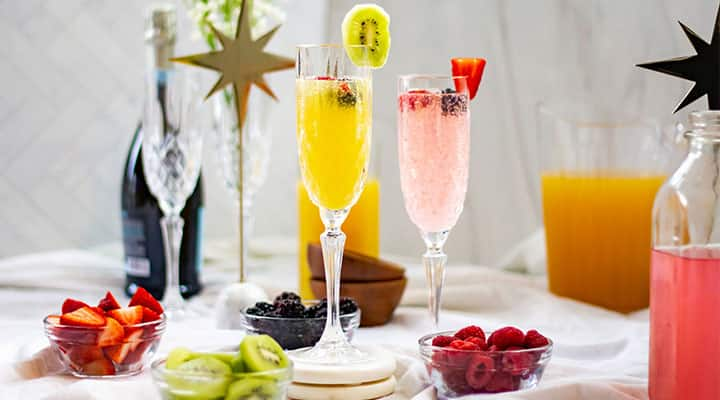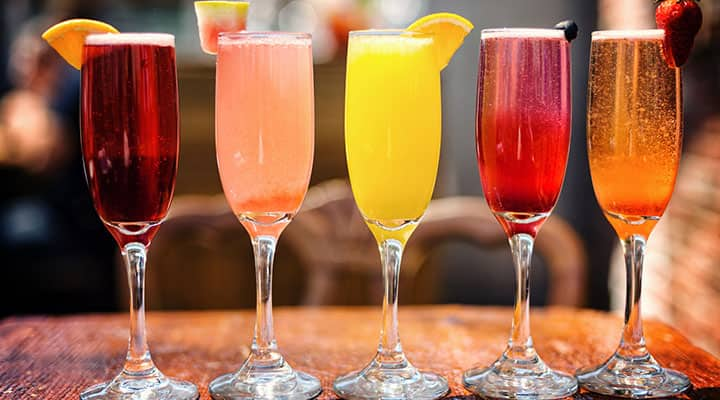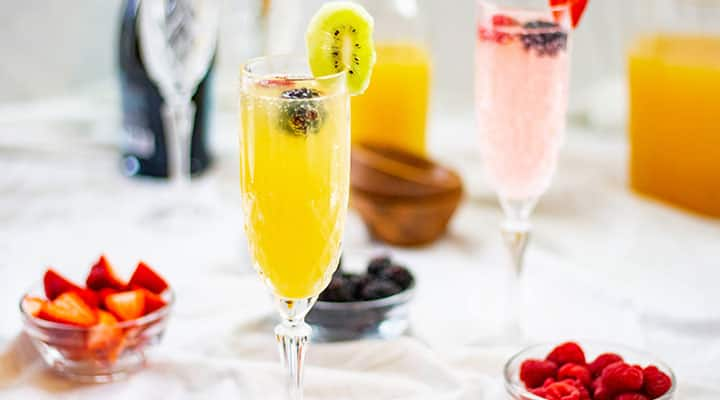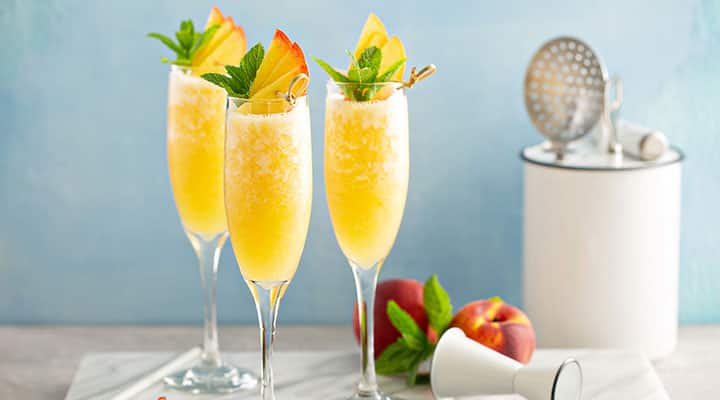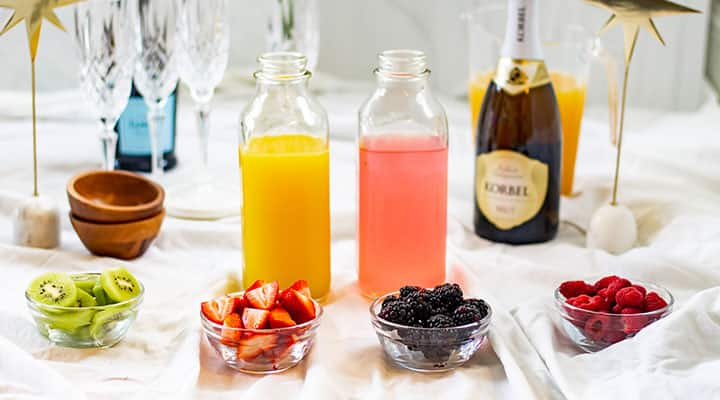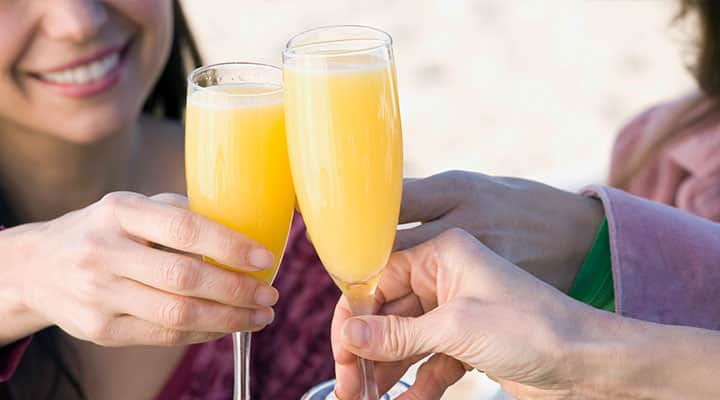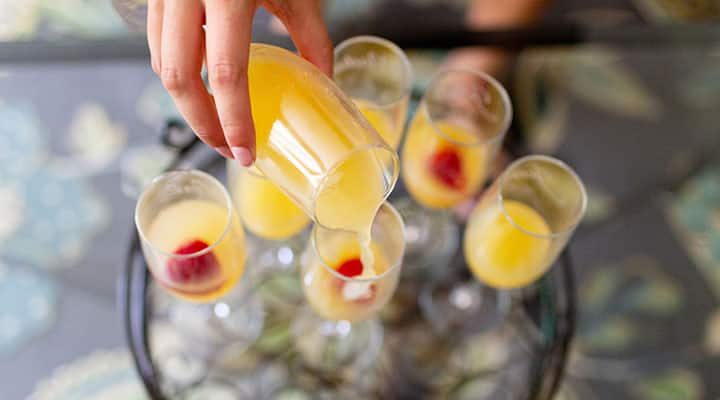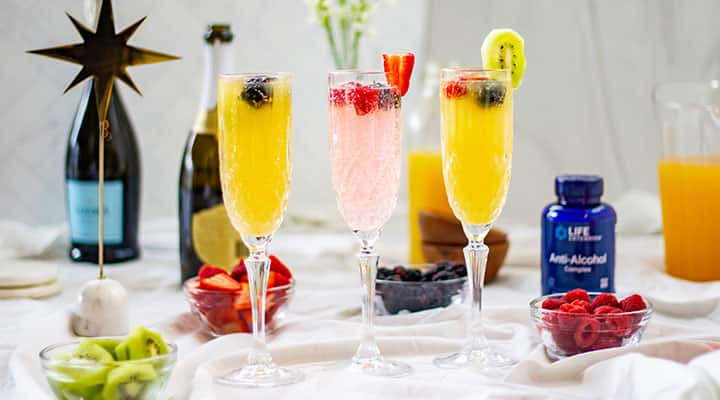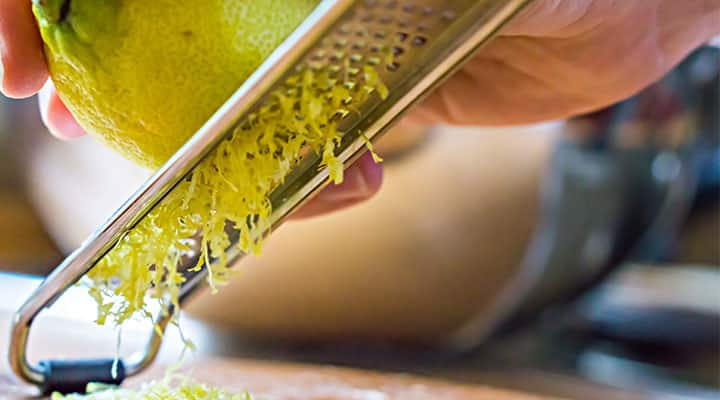
DIY Mimosa Bar: How to Serve Mimosas Like a Professional
Published: December 2023
Nothing says celebration like a bottle of bubbly. It lends a sprinkle of sparkle to your get-together from the first pop! And this light white plays well with citrus and fruit juices, which means getting some beneficial vitamins and minerals into your champagne flute when you enjoy a mimosa or other classic brunch drink.
Whether you're a seasoned entertainer or a first-time host, we're here to help you master the art of the mimosa—and we'll mix in some tips on supporting liver health with your mimosa juices and supplements that help your body process the alcohol in these classic drinks. Get ready to sip, mix and mingle as we dive into creating a glamorous mimosa bar that will elevate your hosting game to pro-level status.
What is a mimosa bar?
A mimosa bar is a great party idea. It is a self-serve station typically set up at events like brunches, bridal showers, baby showers or other celebrations. It consists of a bar of various juices in glass carafes—usually orange juice and other juices like cranberry, peach or mango—alongside bottles of sparkling wine or champagne. Guests can create customized mimosas by combining different mixers with the sparkling wine to suit their preferences.
A DIY mimosa bar may also include fruit garnishes or fresh fruit slices for added decoration and flavor. Mimosa bars offer a fun and interactive way for people to enjoy a popular brunch cocktail while personalizing it to their taste.
When crafting your own mimosa bar, you'll want to start with orange juice. Not only is it the traditional way to make a mimosa, but orange juice is also rich in vitamin C. This vitamin helps protect the body against oxidative stress, supports your immune system health and promotes healthy skin. Grapefruit is another vitamin C-rich juice.
What juices are good for a mimosa bar?
A variety of juices can be offered at a mimosa bar to cater to different tastes and preferences. While orange juice is the classic and most commonly used juice, others work just as well and can add diversity to your DIY mimosa bar. We've got a few ideas to stock your bar:
- Grapefruit juice: The tangy and slightly bitter flavor of grapefruit complements the sweetness of champagne.
- Pineapple juice: Pineapple adds a tropical twist and a slightly tangy, sweet flavor.
- Cranberry juice: Cranberry delivers a tart and refreshing taste to your drink, especially if you're looking for a more vibrant color. Poinsettia drinks are made with cranberry, sparkling wine and a splash of orange liqueur.
- Peach nectar: Peach provides a sweet and aromatic taste that pairs nicely with champagne in another classic brunch cocktail, the bellini.
- Mango juice: Mango offers a sweet, exotic flavor that can add an interesting twist to the traditional mimosa.
- Mixed berry juice: Combining flavors like raspberry, blueberry and strawberry in your champagne flute can create a flavorful and colorful option.
- Apple cider: Particularly popular during the fall season, cider brings a crisp, slightly tangy taste to mimosas.
- Watermelon juice: Watermelon, either as a juice or puree, goes especially well with sparkling wine and adds a pretty pink color to your cocktail.
These juices can be offered alongside the classic orange juice, allowing guests to mix and match to create their preferred mimosa combinations.
Garnishes for your mimosa bar
Allowing guests to personalize their beverages with various garnishes elevates the drink experience significantly. It instantly imparts an air of sophistication to present an array of fresh fruits, herbs and liqueurs; not only do these enhance the flavor, they also add visual appeal.
Try these garnish ideas for your bar:
Citrus slices:
Thinly sliced oranges, lemons, limes or even grapefruit can add a colorful and refreshing touch to your drink—and give it an extra dose of antioxidants. Larger lime slices can be used to add lime juice to sweeter juices, like watermelon.Berries:
Fresh berries like strawberries, raspberries or blueberries work well as a garnish. They not only look appealing but also infuse a burst of flavor into the drink.Herbs:
Fresh herbs like mint, basil, or rosemary can be used as a unique and fragrant garnish, and they add an aromatic element to the juices.Edible flowers:
Delicate and colorful edible flowers such as pansies or violets can be an elegant addition.Fruit skewers:
Skewers with assorted fruit chunks (pineapple, melon, grapes) can be placed on the rim of the glass or directly into the drink as a decorative and flavorful element.Candied or sugared rim:
Using simple syrup to rim the glass with sugar or with candied fruit can be a sweet addition.Fruit zest:
Using twists or zest of citrus fruits to garnish the drink amplifies the citrus aroma and flavor.Pomegranate:
Pomegranate arils lend a tart flavor to your cocktail and deliver a wealth of health benefits as well.Liqueurs:
Setting your bar with shots of triple sec, Grand Marnier or St. Germain allows guests to add a kick of orange and floral flavor to their drinks.
Explore Our Best Liver Health / Detoxification Supplements
Choosing a bubbly for your mimosa bar
When selecting champagne or sparkling wine for a mimosa bar, choose a moderately priced option rather than an extremely expensive one. Because the champagne will be mixed with fruit juice, the subtleties of a pricier bottle will not be as noticeable as they are when you order a bottle of the good stuff for toasts at a bridal shower or wedding.
Here are some considerations for choosing champagne for a mimosa bar:
Affordability:
Look for a reasonably priced champagne that fits within your budget. There's no need to go for the most expensive bottle, as the nuances of a high-end champagne will get lost in the mix.Brut or extra dry:
Champagnes labeled as "Brut" or "extra dry" tend to work well for mimosas. They strike a balance between dryness and sweetness that complements the fruit juice without being overly sweet.Prosecco or Cava:
While these sparkling wines are not champagne (since they don't come from the Champagne region of France), Prosecco (Italian sparkling wine) and Cava (Spanish sparkling wine) are often more affordable alternatives that work wonderfully in mimosas.
Ultimately, the best champagne for a mimosa bar is one that fits your budget, has a good balance of flavors, and complements the juices you're offering. It's about finding a champagne that mixes well with the fruit juice to create a delicious and enjoyable mimosa experience.
How to make a mimosa bar: 4 easy steps
You will need a dedicated space for your bar since it might take up a good deal of room, depending on the number of juices you include.
Gather supplies.
You will need pitchers or carafes for your fruit juices, ice buckets for your bubbly and attractive containers for your garnishes.Chill the champagne.
Keep the bottles in ice buckets or on trays with ice to maintain their temperature.Prepare garnishes.
Slice fresh fruits and arrange your garnishes in bowls, trays or shot glasses for easy use.Decorate.
Set up your mimosa bar sign on your bar cart or table along with your champagne glasses or plastic champagne flutes. If champagne flutes aren't your style, stemless wine glasses make a good go-to. Don't forget to set up a second station with mason jars or other glasses for non-alcoholic mocktails, sparkling waters and other crowd-pleasing drinks, such as iced tea and lemonade.
Mimosa bar ingredients for a party of 10
3 bottles of your favorite sparkling wine
- Champagne
- Prosecco
Juice carafes
- 1 quart orange juice
- 1 quart peach juice
- 1 quart strawberry lemonade
- 1 quart mango juice
Garnishes
- 1 cup of blackberries
- 1 cup of strawberries
- A few kiwi
- 1 cup of raspberries
- 1 orange, sliced
3 drink ideas to try
- Strawberry lemonade with champagne topped with berries
- Orange juice, prosecco and blackberries
- Mango juice and champagne topped with berries (raspberries, blackberries and kiwi)
Step-by-step drink preparation
Add one part juice to two parts sparkling wine to your flute. Garnish with fruit or herbs.
Should mimosas have pulp?
Whether mimosas should have pulp largely depends on personal preference. Traditional mimosas are often made with pulp-free or strained orange juice to create a smoother and clearer drink. The absence of pulp ensures a consistent texture and appearance in the cocktail.
However, some individuals enjoy the added fiber and texture of pulp in their drinks. Pulp can also provide more complexity and depth to the flavor.
Should mimosas be served chilled?
Mimosas are typically made with chilled champagne and chilled fruit juice. Serving them cold enhances their refreshing quality and makes them more enjoyable, especially during brunch or a warm weather occasion.
Champagne is best served at temperatures between 45°F and 48°F to maintain its bubbly effervescence and to highlight its flavors. Likewise, keeping the fruit juice chilled ensures that the overall mimosa is cool and refreshing.
Pre-chill both the champagne and fruit juice before setting up your mimosa bar and keep them in ice buckets to maintain their temperature while serving. Chilled glasses or stemware can also help keep the mimosas cold longer once they're poured.
Are mimosas healthy?
While mimosas are traditionally made with vitamin-rich fruit juices, let's not forget that they are alcoholic cocktails. Whether a food is "healthy" is relative; while a mimosa has some nutritional benefits, it's not as wholesome a choice as, say, a green smoothie. That doesn't mean you can't enjoy them in moderation, though!
Can you make a virgin mimosa?
You can indulge in non-alcoholic mimosa options by using sparkling apple cider, sparkling lemonade, ginger ale or seltzer water in place of champagne to help your body stay hydrated.
You can also supplement to support your liver health and healthy alcohol metabolism. Formulas like Anti-Alcohol Complex promote healthy detoxification and encourage optimal liver function with nutrients that help protect against alcohol metabolites. This supplement also contains powerful antioxidants to protect cells from oxidative stress.
Protect your liver health with formulas designed for your lifestyle. Take our health needs quiz today for a personalized nutrient recommendation.
Resources
- Ruxton CHS, Myers M. "Fruit Juices: Are They Helpful or Harmful? An Evidence Review." Nutrients. May 2021. https://www.ncbi.nlm.nih.gov/pmc/articles/PMC8228760/
- "Grapefruit Benefits." Johns Hopkins Medicine. https://www.hopkinsmedicine.org/health/wellness-and-prevention/grapefruit-benefits
- "Vitamin C." Mayo Clinic. August 2023. https://www.mayoclinic.org/drugs-supplements-vitamin-c/art-20363932

